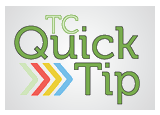TC Quick Tip: 10 Coolest Tools for Student Blogging
by Margareta Tripsa
 Audience: Young and adult learners of any level
Audience: Young and adult learners of any level
Blogs, which are digital platforms that provide individuals with a medium for sharing knowledge and experiences, are becoming increasingly common in today’s technologically-enabled schools. Weblogs or “blogs” are relatively new tools; they began their online existence about a decade and a half ago. Blogs, which represent instant publishing systems, have recently exploded onto the World Wide Web. The use of blogging tools allow students to reach a multitude of curriculum standards and all levels of instruction.
Ten cool ideas for blog posts:
1. Embed talking avatars.
Voki is an effective language tool which enables users to express themselves on the web in their own voice using a talking character. Even a boring topic like idioms captures student attention when asked to create a Voki talking avatar about it. Blabberize is a great Web 2.0 tool that allows students to animate any picture by making it “talk” about whatever topic they might be working on.
2. Create and interpret word clouds.
Create word clouds, which are graphical representations of word frequency, using tools like Wordleor Tagxedo. They provide students with a countless number of ways to interact with key vocabulary.
3. Use Wallwisher.
Use Wallwisher to get your students express opinions, brainstorm topics, or to provide feedback to you.
4. Create and publish e-books.
Help students become instant publishers and writers. Collaborative storytelling tools like StoryBird and StoryJumper help students become part of digital learning communities, which inspires them to develop their narrative talent.
5. Embed student-created comic strips, or cartoons.
Try Chogger, Toondoo, or Strip Generator.
6. Embed Digital Storytelling Projects.
These projects can be created using a variety of tools, such as Microsoft Photostory, ShowMe, VoiceThread, WeVideo, Videolicious, Educreation, and Vimeo.
7. Publish podcasts.
Using PodOmatic, iPadio, or MyPodcast, create and post an audio broadcast over the web, which is broken up into episodes. It engages students because it is an authentic task that involves authentic audiences.
8. Publish prezis.
Prezi, which is a cloud-based presentation, gives students the ability to express their creativity and showcase their knowledge and skills.
9. Publish student created videos.
Publish videos using web tools such as Microsoft MovieMaker, digital cameras, or iOS devices such as iMovie.
10. Have students share their knowledge.
Students can share their knowledge by creating products using the apps or digital tools of their choice. Teachers should focus primarily on the instructional standards to be met, not on specific apps or digital tools. Teachers should be flexible enough to give the students the freedom to use whatever means they want to showcase their knowledge and skills.
See a class blog for examples of student work.
Having the students be not only consumers of content, but also producers of content, gives them the opportunity to manipulate the knowledge and internalize it. Blogging definitely fosters interactive learning and, as a result, students find themselves immersed in dynamic learning environments that help them expand their community of learners from the single setting of their classroom to the entire world. This factor brings a whole new dimension to the learning process.
___________________
Margareta Tripsa is a visiting international faculty in CMS, Charlotte, NC. She earned her Master’s of Arts in TESOL. She loves both engaging students with technology tools and helping teachers build technology fluency while working with ELLs. She is passionate about the TPACK (Technological Pedagogical and Content Knowledge) framework and believes that effective technology integration involves skills and knowledge of technology, pedagogy, and content taken together, not in isolation. Visit her blog, Techie Teachers’ Tricks, for more resources.
TESOL Blogs
Interested in writing a blog for TESOL?
Contact
Tomiko Breland with your idea or for details.
Check out the latest TESOL Blogs:
|
TESOL and the CCSS: Let’s Not Give Up, by Rosa Aronson
 Recently, the media have reported a mounting chorus against the U.S. Common Core State Standards (CCSS). Opponents of the CCSS state that the initiative is an intrusion of the Federal Government into local authority, that it’s really an attempt to impose a national curriculum, and that it simply costs too much to implement. Recently, the media have reported a mounting chorus against the U.S. Common Core State Standards (CCSS). Opponents of the CCSS state that the initiative is an intrusion of the Federal Government into local authority, that it’s really an attempt to impose a national curriculum, and that it simply costs too much to implement.
Personally, I find it hard to buy into many of these arguments because they are built on inaccuracies. Read More. |
|
Online Dictionaries for English Learners, by Tara Arntsen
 While I do not know how popular online dictionaries are with teachers and students, I have noticed that my own students often rely on translators to help them with new vocabulary. Translators definitely serve a purpose and students perceive them as the best resource for learning new words because they can see the new word in both their native language and English. Unfortunately, translators are not all created equally and I have seen some rather odd translations, so I recommend that my students, especially at the higher levels, use online dictionaries to help them. Here I’ll talk about some of the online dictionaries I have found, but it is by no means a comprehensive list. Read More. While I do not know how popular online dictionaries are with teachers and students, I have noticed that my own students often rely on translators to help them with new vocabulary. Translators definitely serve a purpose and students perceive them as the best resource for learning new words because they can see the new word in both their native language and English. Unfortunately, translators are not all created equally and I have seen some rather odd translations, so I recommend that my students, especially at the higher levels, use online dictionaries to help them. Here I’ll talk about some of the online dictionaries I have found, but it is by no means a comprehensive list. Read More.
|
|
Check It Out! Resources for Adult ELLs at the Library, by Alexandra Lowe
 For well over a century, American public libraries have offered a gateway to immigrants learning English. In some cities, free library-based ESL classes are so over-subscribed that lotteries are held to determine who gets in. Countless additional ELLs participate in library-based conversation groups. For well over a century, American public libraries have offered a gateway to immigrants learning English. In some cities, free library-based ESL classes are so over-subscribed that lotteries are held to determine who gets in. Countless additional ELLs participate in library-based conversation groups.
Yet, remarkably, many ELLs who take English classes elsewhere in the U.S. are unaware of what a treasure trove awaits them at their local public library. And thanks to the Internet, certain of the public libraries’ resources may even be accessible well beyond America’s shores to students studying English around the world. Here, in a nutshell, are some of the ways in which I introduce my adult ESL students to what their local public library has to offer: Read More. |
|
“Simplicity is the Ultimate Sophistication,” by Elena Shvidko
 “Simplicity is the Ultimate Sophistication”, a quote from Leonardo da Vinci, for me refers to the simplicity of language, which I would like to reflect on in today’s blog entry. I’ll start with a personal experience. When I was working on my master’s thesis a couple of years ago, I remember the feedback that I received from my academic advisor after he handed back to me the first several pages of my first draft. The word that he used sounded almost hurtful at that moment. He said that the language of my writing was not “crisp”! And then he added, “Less is more.” “Simplicity is the Ultimate Sophistication”, a quote from Leonardo da Vinci, for me refers to the simplicity of language, which I would like to reflect on in today’s blog entry. I’ll start with a personal experience. When I was working on my master’s thesis a couple of years ago, I remember the feedback that I received from my academic advisor after he handed back to me the first several pages of my first draft. The word that he used sounded almost hurtful at that moment. He said that the language of my writing was not “crisp”! And then he added, “Less is more.”
At that moment, I was not quite sure if I understood what the expression “less is more meant,” as I believed that my thesis was supposed to be written in academic language, which, according to me, entailed complicated syntactic structures and long words. Read More. |